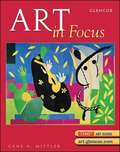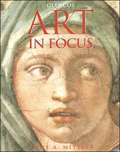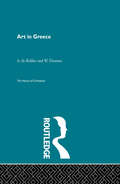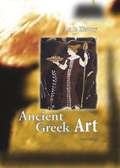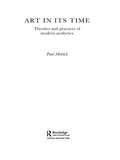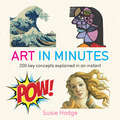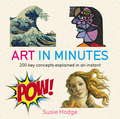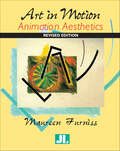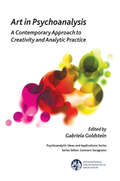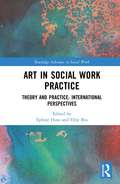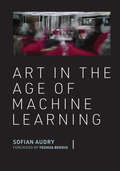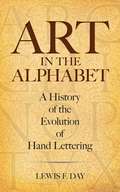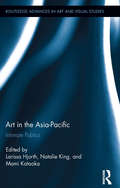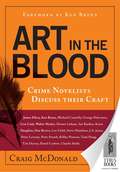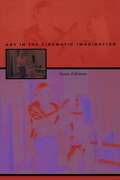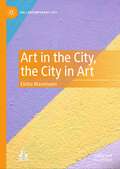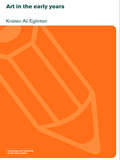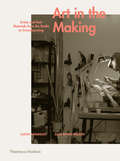- Table View
- List View
Art in Focus: Aesthetics, Criticism, History, Studio (5th edition)
by Gene A. MittlerArt in Focus - the premier high school art history text! An integrated, chronological approach to the study of art, Art in Focus demonstrates the interrelationships of aesthetics, art criticism, art history, and studio art.
Art in Focus (4th Edition)
by Gene A. MittlerTHE MOST IMPRESSIVE AND ACCESSIBLE ART PROGRAM AVAILABLECompletely redesigned, Art in Focus is filled with colorful reproductions, photographs, graphics, and student artwork, all designed to challenge, surprise, and inspire your students to create and appreciate art. Your students expect something a little different from art class. The 2000 edition of Art In Focus offers the kind of inspiration and challenge your students expect. It is filled with more colorful reproductions, photos, and graphics than ever before. It uses both words and graphics to highlight relevant art topics. It integrates technology resources. It even features student artwork, so your students can see that talent can be celebrated and acknowledged at any age.
Art in Greece
by W. Deonna A. de RidderOriginally published between 1920-70,The History of Civilization was a landmark in early twentieth century publishing. It was published at a formative time within the social sciences, and during a period of decisive historical discovery. The aim of the general editor, C.K. Ogden, was to summarize the most up to date findings and theories of historians, anthropologists, archaeologists and sociologists. This reprinted material is available as a set or in the following groupings: * Prehistory and Historical Ethnography Set of 12: 0-415-15611-4: £800.00 * Greek Civilization Set of 7: 0-415-15612-2: £450.00 * Roman Civilization Set of 6: 0-415-15613-0: £400.00 * Eastern Civilizations Set of 10: 0-415-15614-9: £650.00 * Judaeo-Christian Civilization Set of 4: 0-415-15615-7: £250.00 * European Civilization Set of 11: 0-415-15616-5: £700.00
Art in History: Ancient Greek Art
by Susie HodgeExamines the art of ancient Greece, including mosaics, pottery, sculpture, architecture, and paintings.
Art In Its Time: Theories and Practices of Modern Aesthetics
by Paul MattickArt In Its Time takes a close look at the way in which art has become integral to the everyday 'ordinary' life of modern society. It explores the prevalent notion of art as transcending its historical moment, and argues that art cannot be separated from the everyday as it often provides material to represent social struggles and class, to explore sexuality, and to think about modern industry and our economic relationships.
Art in Minutes: 200 Key Concepts Explained In An Instant (In Minutes)
by Susie HodgeThis concise yet comprehensive guide to the history of art is the perfect handbook for all would-be art buffs. Art historian Susie Hodge takes you on a whistle-stop international tour of all the major philosophies, movements, phases, developments, artists, and themes, from prehistoric art to Hyperrealism. Other concepts covered include Greek classicism, Gothic art, the Renaissance, Baroque, Romanticism, Realism, Impressionism, Cubism, surrealism, Pop art, and Minimalism.
Art in Minutes (IN MINUTES)
by Susie HodgeThe perfect compact reference guide for all would-be art buffs. Art historian Susie Hodge takes you on a whistle-stop international tour of all the major artistic cultures, movements, phases, developments, artists and themes, from Prehistoric art to Hyperrealism. Contents also include Greek classicism, Gothic art, the Renaissance, Baroque, Romanticism, Realism, Impressionism, Cubism, surrealism, Pop art and Minimalism.
Art in Minutes
by Susie HodgeThe perfect compact reference guide for all would-be art buffs. Art historian Susie Hodge takes you on a whistle-stop international tour of all the major artistic cultures, movements, phases, developments, artists and themes, from Prehistoric art to Hyperrealism. Contents also include Greek classicism, Gothic art, the Renaissance, Baroque, Romanticism, Realism, Impressionism, Cubism, surrealism, Pop art and Minimalism.
Art in Motion (Fountas & Pinnell Classroom, Guided Reading Grade 5)
by Kate DopirakA Drive to Create Many people think art is only paintings and sculptures. But what about a car? Can it be art too? Learn how some people transform plain old cars into moving works of art. NIMAC-sourced textbook
Art in Motion: Animation Aesthetics
by Maureen FurnissArt in Motion, Revised Edition is the first comprehensive examination of the aesthetics of animation in its many forms. It gives an overview of the relationship between animation studies and media studies, then focuses on specific aesthetic issues concerning flat and dimensional animation, full and limited animation, and new technologies. A series of studies on abstract animation, audiences, representation, and institutional regulators is also included.
Art in Nature (Fountas & Pinnell Classroom, Guided Reading Grade 1)
by Susan StubbsNIMAC-sourced textbook
Art in Psychoanalysis: A Contemporary Approach to Creativity and Analytic Practice (The International Psychoanalytical Association Psychoanalytic Ideas and Applications Series)
by Gabriela GoldsteinA revolution is brewing in psychoanalysis: after a century of struggle to define psychoanalysis as a science, the concept of psychoanalysis as an art is finding expression in an unconventional 'return to Freud' that reformulates the relationship between art and psychoanalysis and in this process, discovers and explores uncharted routes through art to re-think problems in contemporary clinical work. This book explores recent contributions to the status of psychoanalytic thought in relation to art and creativity and the implications of these investigations for todays analytic practice. The title, 'Art in Psychoanalysis', reflects its double perspective: art and its contributions to theory and clinical practice on the one hand, and the response from psychoanalysis and its "interpretation" of art. These essays expose the "aesthetic value of analytic work when it is able to 'create' something new in the relation with the patient". The authors surprise the reader with an immense array of fresh and stimulating hypotheses which reflect the originality of their own creative process that has overturned ideas including the 'application of psychoanalysis' to art and the entity of the object of art.
Art in Public
by Lambert ZuidervaartThis book examines fundamental questions about funding for the arts: Why should governments provide funding for the arts? What do the arts contribute to daily life? Do artists and their publics have a social responsibility? Challenging questionable assumptions about the state, the arts, and a democratic society, Lambert Zuidervaart presents a vigorous case for government funding, based on crucial contributions the arts make to civil society. He argues that the arts contribute to democratic communication and a social economy, fostering the critical and creative dialogue that a democratic society needs. Informed by the author's experience leading a nonprofit arts organization as well as his expertise in the arts, humanities, and social sciences, this book proposes an entirely new conception of the public role of art with wide-ranging implications for education, politics, and cultural policy.
Art in Science Museums: Towards a Post-Disciplinary Approach (Routledge Research in Museum Studies)
by Camilla Rossi-Linnemann Giulia De MartiniArt in Science Museums brings together perspectives from different practitioners to reflect on the status and meaning of art programmes in science centres and museums around the world. Presenting a balanced mix of theoretical perspectives, practitioners’ reflections, and case-studies, this volume gives voice to a wide range of professionals, from traditional science centres and museums, and from institutions born with the very aim of merging art and science practices. Considering the role of art in the field of science engagement, the book questions whether the arts might help curators to convey complex messages, foster a more open and personal approach to scientific issues, become tools of inclusion, and allow for the production of totally new cultural products. The book also includes a rich collection of projects from all over the world, synthetically presenting cases that reveal very different approaches to the inclusion of art in science programmes. Art in Science Museums should be of great interest to academics, researchers and postgraduate students working in the fields of museum studies, cultural heritage management, material culture, science communication and contemporary art. It should also be essential reading for museum professionals looking to promote more reflective social science engagement in their institutions.
Art in Science Museums: Towards a Post-Disciplinary Approach (Routledge Research in Museum Studies)
by Camilla Rossi-Linnemann Giulia De MartiniArt in Science Museums brings together perspectives from different practitioners to reflect on the status and meaning of art programmes in science centres and museums around the world.Presenting a balanced mix of theoretical perspectives, practitioners’ reflections, and case-studies, this volume gives voice to a wide range of professionals, from traditional science centres and museums, and from institutions born with the very aim of merging art and science practices. Considering the role of art in the field of science engagement, the book questions whether the arts might help curators to convey complex messages, foster a more open and personal approach to scientific issues, become tools of inclusion, and allow for the production of totally new cultural products. The book also includes a rich collection of projects from all over the world, synthetically presenting cases that reveal very different approaches to the inclusion of art in science programmes.Art in Science Museums should be of great interest to academics, researchers and postgraduate students working in the fields of museum studies, cultural heritage management, material culture, science communication and contemporary art. It should also be essential reading for museum professionals looking to promote more reflective social science engagement in their institutions.
Art in Social Work Practice: Theory and Practice: International Perspectives (Routledge Advances in Social Work)
by Ephrat Huss Eltje BosThis is the first book ever to be published on arts use in social work. Bringing together theoretical connections between arts and social work, and with practice examples of arts in micro and macro social work practice from around the world, the book aims to inspire the reader with new ideas. It provides specific skills, defines what is social rather than fine or projective art use, and explains the theoretical connection between art and social work. It has chapters from all over the world, showing how arts are adjusted to different cultural contexts. Section I explores the theoretical connections between art and social work, including theories of resilience, empowerment, inclusion and creativity as they relate to art use in social work. Section II describes specific interventions with different populations. Each chapter also summarizes the skills and hands-on knowledge needed for social workers to use the practical elements of using arts for social workers not trained in these fields. The third section does the same for arts use in community work and as social change and policy. Using Art in Social Work Practice provides theoretical but also hands-on knowledge about using arts in social work. It extends the fields of both social work and arts therapy and serves as a key resource for students, academics and practitioners interested in gaining the theoretical understanding and specific skills for using social arts in social work, and for arts therapists interested in using social theories.
Art in the Age of Machine Learning (Leonardo)
by Sofian AudryAn examination of machine learning art and its practice in new media art and music. Over the past decade, an artistic movement has emerged that draws on machine learning as both inspiration and medium. In this book, transdisciplinary artist-researcher Sofian Audry examines artistic practices at the intersection of machine learning and new media art, providing conceptual tools and historical perspectives for new media artists, musicians, composers, writers, curators, and theorists. Audry looks at works from a broad range of practices, including new media installation, robotic art, visual art, electronic music and sound, and electronic literature, connecting machine learning art to such earlier artistic practices as cybernetics art, artificial life art, and evolutionary art. Machine learning underlies computational systems that are biologically inspired, statistically driven, agent-based networked entities that program themselves. Audry explains the fundamental design of machine learning algorithmic structures in terms accessible to the nonspecialist while framing these technologies within larger historical and conceptual spaces. Audry debunks myths about machine learning art, including the ideas that machine learning can create art without artists and that machine learning will soon bring about superhuman intelligence and creativity. Audry considers learning procedures, describing how artists hijack the training process by playing with evaluative functions; discusses trainable machines and models, explaining how different types of machine learning systems enable different kinds of artistic practices; and reviews the role of data in machine learning art, showing how artists use data as a raw material to steer learning systems and arguing that machine learning allows for novel forms of algorithmic remixes.
Art in the Alphabet: A History of the Evolution of Hand Lettering
by Lewis F. DayThis grand compilation presents more than 250 depictions of the alphabet's changing forms, from handsome Roman letters cut in marble and delicate English courthand to sixteenth-century Greek initials and modern styles inspired by Gothic, Japanese, and other forms of writing. In addition to its intriguing survey of historical trends, this book also offers richly illustrated reflections on the artistic ability involved in rendering the alphabet. An introductory essay traces the evolution of the English alphabet, followed by a wealth of old alphabets arranged in order of date. Among the selection of modern alphabets are samples that offer evidence of how the surface — wood, stone, leather, mosaic — and the writing instrument — chisel, needle, brush, stylus, pen — can affect the character of the lettering. An assortment of ampersands and numerals concludes the volume, along with an index of illustrations arranged by artist, country, material and process, and style. Artists, graphic artists, historians, and anyone with an interest in calligraphy will appreciate the historic sweep and artistic range of this treasury of lettering.
Art in the Asia-Pacific: Intimate Publics (Routledge Advances in Art and Visual Studies)
by Larissa Hjorth Natalie King Mami KataokaAs social, locative, and mobile media render the intimate public and the public intimate, this volume interrogates how this phenomenon impacts art practice and politics. Contributors bring together the worlds of art and media culture to rethink their intersections in light of participatory social media. By focusing upon the Asia-Pacific region, they seek to examine how regionalism and locality affect global circuits of culture. The book also offers a set of theoretical frameworks and methodological paradigms for thinking about contemporary art practice more generally.
Art in the Blood
by Craig McdonaldJames Ellroy, Dan Brown, Ian Rankin, George Pelacanoes, Ken Bruen, Michael Connelly, Ridley Pearson . . . the roster of writers interviewed in these pages includes those who have won Edgar, Shamus, Anthony and Macavity awards. The interviews were conducted in person, or by phone, or both. Significantly, none of the interviews were placed before the authors for approval, massaging or tweaking of answers. The interviews were recorded on tape and are presented without rejuxtaposition or revision on the part of the novelists. This is how the writers spoke, what they said, casually, candidly and, more importantly, on the fly.
Art in the Cinematic Imagination
by Susan FellemanBringing an art historical perspective to the realm of American and European film, "Art in the Cinematic Imagination" examines the ways in which films have used works of art and artists themselves as cinematic and narrative motifs.
Art in the City, the City in Art (The Contemporary City)
by Elisha MasemannThis Book examines an interplay between discourses on the city that stress the need for rational-functional order and art’s imaginative deviations from the topdown structures of urban life. Moving between theory and praxis, the book situates the city as both a concept and physical construct through which lives and possibilities are shaped or defined. In response, certain modalities of art create spontaneous, non-rational and playful interludes that risk escape from the urban apparatus and a hyper-valorisation of rational order. A three-part framework is used to discuss this push-pull dynamic and to assess the strategies of shock, performative embodiment and intervention that emerged in post-war art movements and in contemporary performance and participatory art practices. The book examines how the disturbances introduced by artists throw the city construct into sharp relief, making it visible and activating momentary encounters where new modes of expression can emerge. This Book offers a new approach to interdisciplinary studies of art and urbanity. The book aims to delineate how the city—as concept and construct—is made visible through artistic practice and in turn challenged or interrogated. Students, researchers and professionals with an interest in the interaction between art and urban studies will discover a new perspective on how urban conditions and issues have been addressed through artistic practice. The book contributes to an evolving discourse in the urban humanities through an exposition of the city’s default construct that is made visible or reimagined through visual art in public spaces.
Art in the Early Years (Teaching And Learning In The Early Years Ser.)
by Kristen Ali EglintonFor all involved in teaching young children, this timely book offers the necessary tool with which to develop a broad, creative and inspirational visual arts programme. Presented in two parts, this text covers both theoretical and practical angles: part one investigates contemporary early childhood art education, challenging what is traditionally considered an early years art experience part two puts theory to text by presenting the reader with numerous inventive visual art lessons that imaginatively meet goals for creative development issued by the QCA. The author strikes the perfect balance between discussion of the subject and provision of hands-on material for use in lessons, which makes this book a complete art education resource for all involved in early years art education. Teachers, trainee teachers, or nursery teachers, who wish to implement a more holistic art curriculum in the classroom whilst meeting all the required standards, will find this an essential companion.
Art in the Hellenistic World
by Andrew StewartWhat was Hellenistic art, and what were its contexts, aims, achievements, and impact? This textbook introduces students to these questions and offers a series of answers to them. Its twelve chapters and two "focus" sections examine Hellenistic sculpture, painting, luxury arts, and architecture. Thematically organized, spanning the three centuries from Alexander to Augustus, and ranging geographically from Italy to India and the Black Sea to Nubia, the book examines key monuments of Hellenistic art in relation to the great political, social, cultural, and intellectual issues of the time. It is illustrated with 170 photographs (mostly in color, and many never before published) and contextualized through excerpts from Hellenistic literature and inscriptions. Helpful ancillary features include maps, appendices with background on Hellenistic artists and translations of key documents, a full glossary, a timeline, brief biographies of key figures, suggestions for further reading, and bibliographical references.
Art in the Making: Artists and their Materials from the Studio to Crowdsourcing
by Glenn Adamson Julia Bryan-WilsonThe first book to address the significance of the materials and methods used to make contemporary artworks Today, artists are able to create using multiple methods of production--from painting to digital technologies to crowdsourcing--some of which would have been unheard of just a few decades ago. Yet, even as our means of making art become more extraordinary and diverse, they are almost never addressed in their specificity. While critics and viewers tend to focus on the finished products we see in museums and galleries, authors Glenn Adamson and Julia Bryan-Wilson argue that the materials and processes behind the scenes used to make artworks are also vital to current considerations of authorship and to understanding the economic and social contexts from which art emerges. This wide-ranging exploration of different methods and media in art since the 1950s includes nine chapters that focus on individual processes of making: Painting, Woodworking, Building, Performing, Tooling Up, Cashing In, Fabricating, Digitizing, and Crowdsourcing. Detailed examples are interwoven with the discussion, including visuals that reveal the intricacies of techniques and materials. Artists featured include Ai Weiwei, Alice Aycock, Isa Genzken, Los Carpinteros, Paul Pfeiffer, Doris Salcedo, Santiago Sierra, and Rachel Whiteread.
